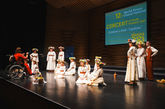Venues








The Musikverein is Vienna's most famous center for classical music. Going to a concert here is about getting to know Vienna as a city of music in a setting of the very finest quality. And musical greats such as the Vienna Philharmonic.
The Large Musikverein Hall, also called the "Golden Hall", is famous for its sumptuous decor. Apollo and the muses draw the eye to the ceiling, while the columns are designed as female figures of the ancient world. As incomparable as the look are the spatial acoustics - the sound experiences here are unique in the world. The New Year's Concert by the Vienna Philharmonic is broadcast to an international TV audience of millions from the Golden Hall each year. The Musikverein offers first-class concerts on the other 364 days of the year as well. With Vienna's leading orchestras: the Vienna Philharmonic, the Wiener Symphoniker, and the Vienna Radio Symphony Orchestra.
Vienna City Hall -The Festival Hall
Designed by Friedrich von Schmidt and completed in 1883, the Ceremonial Hall in the iconic Vienna City Hall stands as a symbol of Vienna's cultural and political significance. We are immensely honored and deeply appreciative of the extensive support provided by the Vienna city government, which enables us to hold the opening concert of the "World Peace Choral Festival" in this historic venue. This support underscores Vienna's dedication to promoting culture and international harmony through the universal language of music.
Rotunda United Nations Headquarters
The United Nations Office at Vienna (UNOV) was established on 1 January 1980 as the third United Nations Headquarters after New York and Geneva (and before Nairobi). It performs representation and liaison functions with permanent missions to the United Nations (Vienna), the host Government and intergovernmental and non-governmental organizations in Vienna.
Each year, the United Nations Headquarters in Vienna (VIC) invite the participants of the "World Peace Choral Festival" to visit VIC and perform on the ground of VIC. Thousands of children and youth from around the world sing beautiful songs and evoking emotional melodies beneath the flags of nations and create an atmosphere that resonates with audiences and media worldwide.
The Votive Church was consecrated on April 24, 1879, on the day of the silver wedding anniversary of Emperor Franz Joseph and Empress Elisabeth. Planning began in 1854, just a few months after a failed assassination attempt on the emperor. In gratitude for his rescue, his brother, Archduke Ferdinand Maximilian (later Emperor of Mexico), collected donations for the construction of the church. Votive churches are usually built as a thank you for being rescued from a dire situation - hence the name. The architect Heinrich von Ferstel was eventually commissioned to build it.
The Rectory Church of St. Peter, one of the most beautiful baroque churches in Vienna, built between 1701 and 1733 according to plans by Lukas von Hildebrandt. The first church in our city stood on this spot in the 4th century, near the Roman camp of Vindobona. Since then, services have been held here. Liturgy and pastoral care make St. Peter a spiritual focal point of the city for locals and foreigners alike
MuTh-Concert Hall of Vienna Boys Choir
Vienna's new venue for music and theater - the Vienna Boys Choir Concert Hall in Augarten opened in December 2012. An exciting new venue has emerged in the heart of Vienna, a place with a focus on young people where music and theater come together. It is also the permanent performance venue of the world-renowned Vienna Boys Choir.
Urania is a public educational institution and observatory located in Vienna's first district, celebrated for its neo-baroque architecture. Founded in 1897 and operational since 1910, Urania has become an essential part of Vienna's cultural and educational landscape, offering a wide range of public lectures and courses. This prestigious venue, closely associated with Vienna's royal and musical heritage, will now host workshops, leveraging its rich historical ambiance to enhance the learning experience in music and other themes.
The University of Music and Performing Arts in Vienna
The University of Music and Performing Arts in Vienna (German: Universitat fur Musik und darstellende Kunst Wien, abbreviated MDW) is an Austrian university located in Vienna. It was established in 1817 by the Society for the Friends of Music and was nationalized in 1909 as the Imperial Academy of Music and the Performing Arts. In 1998, the university assumed its current name to reflect its university status, which was achieved as part of a comprehensive 1970 reform for Austrian Arts Academies. Today, with a student population exceeding three thousand, it stands as the largest institution of its kind in Austria and one of the largest in the world. Notable musicians who have been associated with the university include Herbert von Karajan, Zubin Mehta, and Jean Sibelius.




































